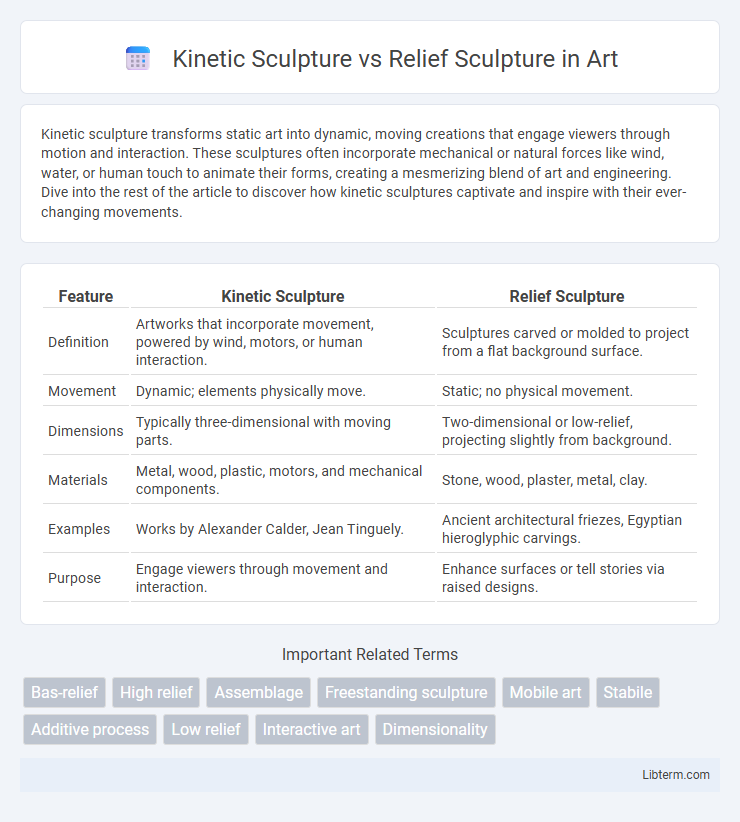Kinetic sculpture transforms static art into dynamic, moving creations that engage viewers through motion and interaction. These sculptures often incorporate mechanical or natural forces like wind, water, or human touch to animate their forms, creating a mesmerizing blend of art and engineering. Dive into the rest of the article to discover how kinetic sculptures captivate and inspire with their ever-changing movements.
Table of Comparison
| Feature | Kinetic Sculpture | Relief Sculpture |
|---|---|---|
| Definition | Artworks that incorporate movement, powered by wind, motors, or human interaction. | Sculptures carved or molded to project from a flat background surface. |
| Movement | Dynamic; elements physically move. | Static; no physical movement. |
| Dimensions | Typically three-dimensional with moving parts. | Two-dimensional or low-relief, projecting slightly from background. |
| Materials | Metal, wood, plastic, motors, and mechanical components. | Stone, wood, plaster, metal, clay. |
| Examples | Works by Alexander Calder, Jean Tinguely. | Ancient architectural friezes, Egyptian hieroglyphic carvings. |
| Purpose | Engage viewers through movement and interaction. | Enhance surfaces or tell stories via raised designs. |
Defining Kinetic Sculpture
Kinetic sculpture is a form of art that incorporates movement as an essential aspect, often powered by wind, motors, or manual interaction, creating dynamic visual experiences. Unlike relief sculpture, which is fixed and projects from a flat surface, kinetic sculptures engage viewers through motion and changing perspectives. This interactive element transforms the artwork into an evolving piece, emphasizing the relationship between space, time, and viewer participation.
Understanding Relief Sculpture
Relief sculpture is a three-dimensional artwork where elements are carved or molded to project from a flat background, creating an illusion of depth without full in-the-round sculpting. It can be classified into bas-relief (low relief) and high relief, depending on the degree of projection from the surface. Unlike kinetic sculpture, relief sculpture remains static, emphasizing texture and form on walls or panels rather than movement or interaction.
Historical Evolution of Both Forms
Kinetic sculpture emerged in the early 20th century as artists like Alexander Calder introduced movement into art, transforming static forms into dynamic expressions using mechanisms and natural forces like wind. Relief sculpture has roots in ancient civilizations such as Mesopotamia and Egypt, where it was used extensively to depict narratives and religious themes on walls and monuments, evolving from low relief (bas-relief) to high relief techniques over centuries. Both forms reflect shifts in artistic intent and technology, with kinetic sculpture emphasizing interaction and temporality while relief sculpture maintains a focus on storytelling and surface depth.
Materials and Techniques Used
Kinetic sculpture employs dynamic materials such as metals, plastics, and motors to create artworks that move or change, relying on engineering techniques like balance, tension, and mechanical components. Relief sculpture, on the other hand, is crafted from solid materials including stone, wood, or plaster, using carving, molding, or casting techniques to create images that project from a flat background. The distinct material choices and fabrication methods define each sculpture's interaction with space and viewer perception.
Role of Movement in Kinetic Sculpture
Kinetic sculpture uniquely incorporates physical movement as a fundamental element, engaging viewers through dynamic interaction and transforming perception over time. Unlike relief sculpture, which remains static and fixed to a surface, kinetic sculptures use mechanical or natural forces such as wind or motors to create continuous or intermittent motion. This integration of movement challenges traditional notions of sculpture by adding temporal and spatial variability, enhancing the sensory experience and emotional impact.
Spatial Depth in Relief Sculpture
Relief sculpture exploits spatial depth by carving or molding figures that project from a flat background, creating varying degrees of dimensionality from low (bas-relief) to high relief. This manipulation of spatial depth allows for detailed storytelling within a confined surface, enhancing visual perception through shadows and layered contours. In contrast, kinetic sculpture emphasizes movement and dynamic interaction with space, offering a fluid experience rather than the fixed spatial depth characteristic of relief works.
Artistic Intent and Viewer Interaction
Kinetic sculpture emphasizes movement and change over time, engaging viewers through dynamic interaction and continuous transformation, which reflects the artist's intent to incorporate physical motion as a core expressive element. Relief sculpture, by contrast, relies on a fixed, three-dimensional design projected from a flat surface to create depth and narrative, aiming to evoke emotional response through visual storytelling and tactile illusion without physical movement. Both forms shape viewer experience distinctly, with kinetic sculptures inviting active participation and relief sculptures fostering contemplative observation.
Iconic Examples of Each Sculpture Type
The Flamingo by Alexander Calder is an iconic kinetic sculpture, renowned for its dynamic movement and vibrant red color, showcasing the essence of mobile art. In contrast, Michelangelo's The Battle of Cascina is a seminal relief sculpture exemplifying intricate detail and depth carved into marble, illustrating a historic battle scene. Both sculptures represent distinct artistic approaches, with kinetic art emphasizing motion and relief sculpture focusing on three-dimensional imagery on flat surfaces.
Challenges in Creation and Display
Kinetic sculpture presents challenges in creation due to the need for precise engineering to achieve smooth motion, durability, and balance, often requiring specialized materials and mechanisms that withstand environmental factors. Relief sculpture demands mastery in depth perception and spatial composition, as artists must effectively convey three-dimensionality on a flat surface while ensuring the structural integrity of varied depths. Displaying kinetic sculptures involves securing adequate space and safety measures for moving parts, whereas relief sculptures require optimal lighting and wall support to enhance texture and shadow effects without compromising stability.
Contemporary Trends and Innovations
Contemporary kinetic sculptures integrate advanced materials such as lightweight alloys and smart sensors to create interactive, motion-driven experiences, pushing the boundaries of viewer engagement. Relief sculptures have evolved with digital fabrication techniques like 3D printing and laser cutting, enabling intricate surface textures and multi-layered depth effects that challenge traditional flatness. Artists increasingly blend kinetic and relief elements, using augmented reality and responsive technologies to produce hybrid works that transform static forms into dynamic narratives.
Kinetic Sculpture Infographic

 libterm.com
libterm.com